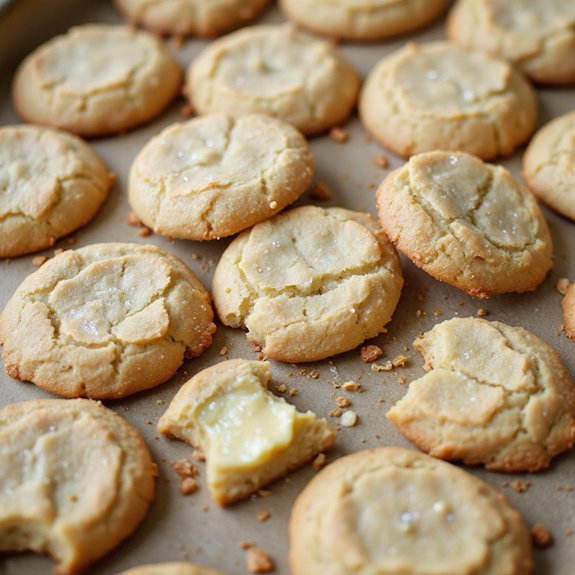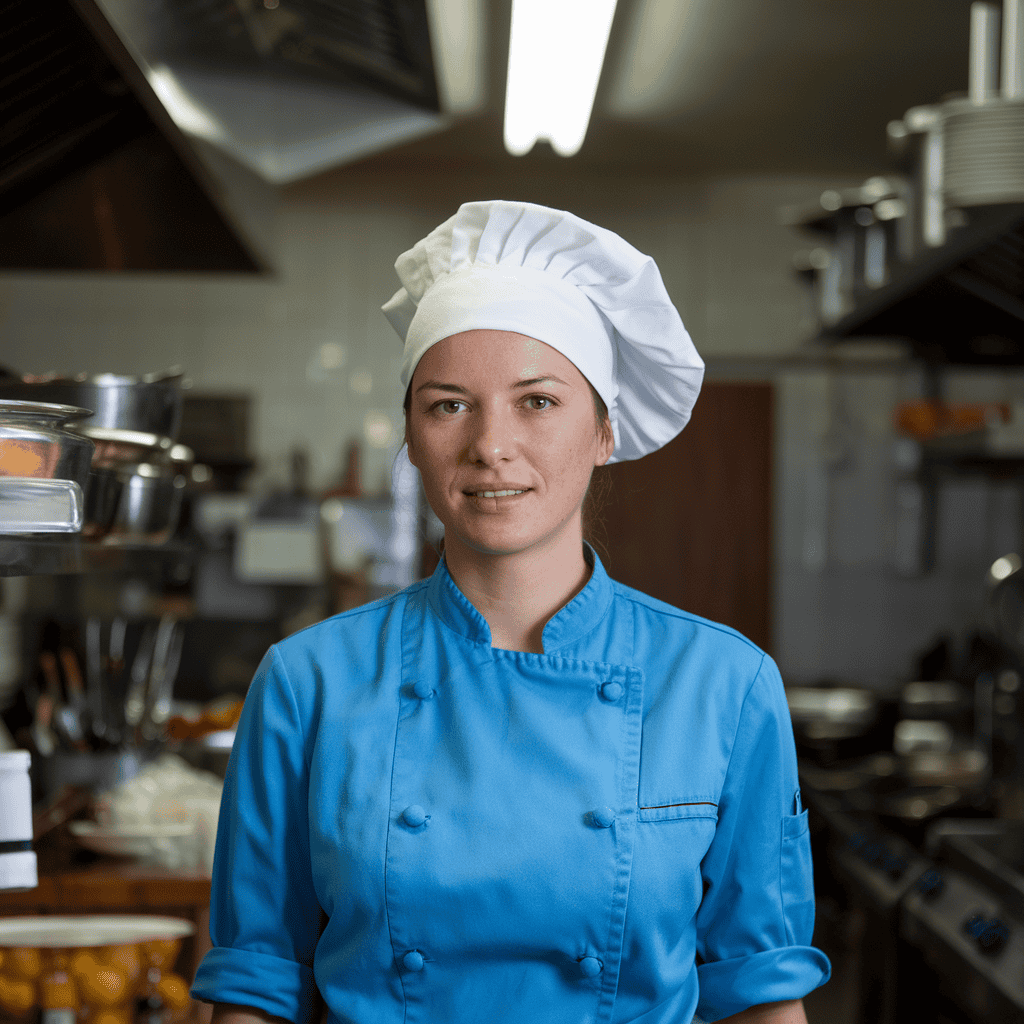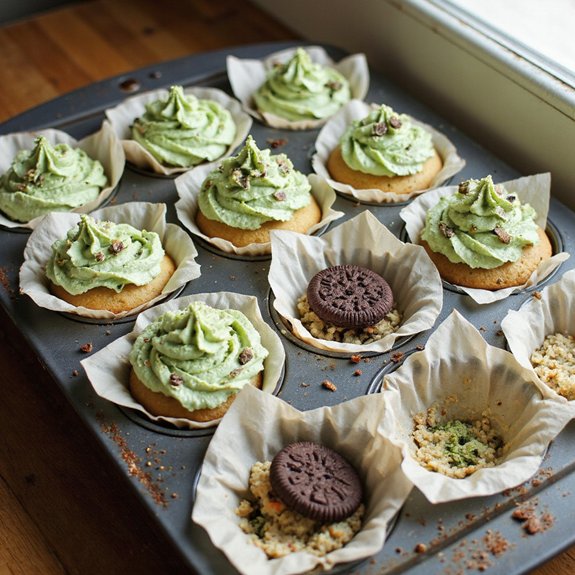Picture a tray of golden, sugar-dusted rounds, their crinkled tops catching the light, butter and vanilla perfuming the kitchen with cozy bakery warmth.
Bite in and the edges give way to a tender, chewy center—soft as custard, sweet as a hug after a long day.
These cookies are my comfort compass: simple to make, unfussy to bake, and always, always the first to disappear.
I first leaned on this recipe when a late-afternoon school recital turned dinner into a scramble—thirty minutes of chilling while the oven preheated, and we still had warm cookies for dessert and lunchbox treats for the next day.
They’re perfect for busy weeknights, Sunday suppers, or whenever you need a quick tray for neighbors, potlucks, and office pick-me-ups.
With pantry staples and a boost from custard powder, they deliver bakery texture without fuss.
Ready? Let’s cook!
Why You’ll Love It
- Delivers bold vanilla flavor with custard powder and paste
- Produces irresistibly chewy, tender centers every bake
- Uses simple pantry staples and basic equipment
- Chills quickly for faster, weeknight-friendly cookies
- Freezes beautifully for make-ahead treats
Ingredients
- 170 g unsalted butter softened — room temp for best creaming (use good European-style if possible)
- 200 g granulated sugar — superfine dissolves evenly (choose pure cane)
- 50 g light brown sugar packed — adds moisture and chew (fresh, soft)
- 1 large egg room temperature — binds and enriches (free-range if possible)
- 2 large egg yolks room temperature — extra richness and chew (separate cleanly)
- 2 tsp vanilla extract — deep flavor base (use pure, not imitation)
- 1 tsp vanilla bean paste optional — boosts vanilla specks (look for real seeds)
- 260 g all-purpose flour — provides structure (unbleached, medium protein)
- 40 g instant vanilla custard powder — signature flavor/texture (Bird’s or similar)
- 1/2 tsp baking soda — lift and spread control (fresh, not clumpy)
- 1/2 tsp baking powder — balanced rise (aluminum-free preferred)
- 1/2 tsp fine sea salt — sharpens sweetness (avoid iodized)
- 2 tbsp granulated sugar for rolling — light sparkle and crunch (shallow dish)
Step-by-Step Method
Prep Your Pans
Line two sheet pans with silicone mats or parchment. Set them aside. Gather all tools and ingredients to streamline the process. Make certain butter and eggs are at room temperature for proper mixing. Have a wire rack ready for cooling. Place extra granulated sugar in a small bowl for rolling later.
Whisk Dry Ingredients
Whisk flour, custard powder, baking soda, baking powder, and salt in a mixing bowl. Blend until the mixture looks uniform, with no streaks of powder. This step distributes leaveners evenly. Set the bowl aside. Keep your whisk handy for quick recombining if needed before adding to wet ingredients.
Cream Butter & Sugars
Beat softened butter with granulated sugar and brown sugar on medium-high speed. Continue for about two minutes until light and fluffy. Scrape the bowl and beater to ensure even creaming. Proper aeration helps create chewy centers and set edges. Avoid overmixing to prevent too much spread.
Add Eggs & Vanilla
Beat in the whole egg until fully incorporated. Add the egg yolks, vanilla extract, and vanilla bean paste. Mix until smooth, glossy, and cohesive. Scrape the bowl once to catch any unmixed spots. The extra yolks enhance richness and chew. Don’t overbeat after the mixture looks silky.
Combine Wet & Dry
Add the dry ingredients to the wet mixture. Mix on low speed until no dry streaks remain. Stop as soon as the dough looks uniform. Finish folding with a rubber spatula to catch the bottom and sides. Avoid overworking to maintain tenderness. The dough should feel soft but not sticky.
Chill the Dough
Cover the bowl and refrigerate the dough for 30 minutes. This firms the butter slightly and reduces spread. Chill longer, up to 1–2 hours, for thicker cookies. If your kitchen is warm, consider an extra 10–15 minutes. Meanwhile, preheat the oven to 350°F (175°C) to be ready for baking.
Preheat the Oven
Preheat to 350°F (175°C) while the dough chills. Position an oven rack in the center for even baking. Make certain the oven reaches full temperature before baking the first tray. Prepare your rolling sugar in a small bowl. Have your cookie scoop ready for fast portioning.
Scoop & Roll
Scoop 1.5-tablespoon portions of dough using a cookie scoop. Roll into smooth balls with your palms. Lightly coat each ball in granulated sugar. Don’t pack the sugar; a thin coating is ideal. Place the sugared balls back in the bowl while arranging trays, keeping them cool.
Arrange on Trays
Space dough balls 2 inches apart on prepared pans. Aim for 12 balls per sheet to allow room for spreading. If the dough has softened, chill the tray for five minutes. Keep the second tray refrigerated while the first bakes. This helps maintain cookie height and defined edges.
Bake Until Just Set
Bake one sheet at a time for 9–11 minutes. Look for set edges and puffy, slightly underdone centers. For crinkles, bang the pan once at minute eight. Don’t overbake; carryover heat finishes the centers. Rotate the pan once if your oven browns unevenly.
Cool & Finish
Let cookies cool on the pan for five minutes to firm the structure. Transfer to a wire rack to cool completely. Repeat with remaining dough. Store cooled cookies in an airtight container for up to four days. Freeze leftovers for up to two months, well wrapped to prevent dryness.
Ingredient Swaps
- No custard powder: Use instant vanilla pudding mix (40 g). Reduce granulated sugar by 1–2 tbsp to balance sweetness.
- Gluten-free: Replace all-purpose flour with a 1:1 gluten-free baking blend; add 1/4 tsp xanthan gum if your blend lacks it.
- Dairy-free: Swap butter for vegan butter sticks; guarantee custard/pudding mix is dairy-free.
- Egg-free: Use 1/4 cup aquafaba or commercial egg replacer for the whole egg; replace each yolk with 1 tbsp dairy-free yogurt or additional aquafaba.
- Vanilla bean paste: Omit or add 1/2 tsp extra vanilla extract; a scraped 1/2 vanilla bean also works.
- Brown sugar: Use all granulated sugar plus 1 tsp molasses; or coconut sugar (slightly less chewy).
- Regional: If custard/pudding mixes aren’t available, add 1 tbsp cornstarch + increase vanilla extract by 1 tsp; texture will be slightly less custardy.
You Must Know
Doneness • If edges look set but centers are domed and soft with a slight sheen, pull the tray at 9–11 minutes; residual heat finishes them.
Over-dull, flat centers mean they went too long and will be crisp, not chewy.
Troubleshoot • When cookies spread into thin puddles by minute 6–7, scoop remaining dough back into the fridge 15–20 minutes and dust in 10–15 g flour.
Warmer butter or low flour weakens structure; slight chilling and a small flour boost restore thickness.
Scale • For half-batch or double-batch accuracy, weigh eggs: 1 large egg ≈ 50 g without shell; 1 yolk ≈ 18 g.
Keep total egg mass proportional so moisture and chew stay consistent.
Flavor Boost • To amplify vanilla, swap 20 g of the granulated sugar for 20 g of superfine sugar and add 1–2 g freshly scraped vanilla bean; superfine sugar dissolves faster, enhancing aromatic lift without changing spread.
Make-Ahead • For best shape on busy days, portion and sugar-coat, then freeze solid on a tray 1–2 hours; store airtight up to 2 months.
Bake from frozen at 350°F adding 1–2 minutes; edges should set while centers stay puffy.
Serving Tips
- Serve warm with a scoop of vanilla bean ice cream.
- Pair with hot tea, chai, or a latte for cozy contrast.
- Sandwich two with whipped cream or vanilla buttercream.
- Crumble over fresh berries and lightly sweetened whipped cream.
- Plate with a drizzle of salted caramel and a pinch of sea salt.
Storage & Make-Ahead
Store cookies airtight at room temperature 3–4 days.
In the fridge, up to 1 week, though texture is best at room temp.
Dough can be made ahead: chill up to 48 hours.
For longer storage, freeze baked cookies or portioned dough balls up to 2 months.
Bake from frozen, adding 1–2 minutes.
Reheating
Reheat gently.
Microwave one cookie 8–12 seconds.
Oven: 300°F (150°C) for 4–6 minutes on a sheet.
Stovetop: warm covered skillet on low 2–3 minutes.
Avoid overbaking.
Cool slightly.
County-Fair Bake-Sale Favorite
Often the first thing to vanish from a bake-sale table, these chewy vanilla custard sugar cookies glow like little suns under the tent lights.
I stack them in neat rows, sugared edges twinkling, and the air fills with warm vanilla and butter.
You bite one, and the custard-soft center gives, tender and chewy, like a hug you can taste.
I love watching kids trade quarters for seconds while parents sneak thirds, napkins perfumed with sweetness.
- Package in clear bags tied with twine; slip a handwritten label: “Vanilla Custard Chews—baked today.”
- Offer warm samples on tiny squares of parchment; the aroma does the selling.
- Price by trio; include a “baker’s dozen” deal to move the last, still-sparkling batch.
Final Thoughts
Ready to bake? Give these chewy vanilla custard sugar cookies a try, then tweak to your taste—add lemon zest, swap in almond extract, or chill longer for extra thickness.
Enjoy and let me know your favorite twist!
Frequently Asked Questions
Can I Make These Cookies Gluten-Free Without Gritty Texture?
Yes—you can. I swap in a quality 1:1 gluten-free blend with xanthan gum, sift lightly, and rest the dough 45 minutes. I add a tablespoon milk and cornstarch, yielding tender, chewy centers and delicate, sugared edges.
How Do High-Altitude Adjustments Affect Baking Time and Spread?
At altitude, I bake hotter and shorter, add a spoon of flour, and reduce sugar slightly—less spread, quicker set. I watch edges kiss gold, centers puff like little clouds, aromas curling warm and sweet.
What Mixer Speed Prevents Overaerating and Domed Cookies?
Use medium speed for creaming, then switch to low as flour joins. I watch butter-sugar turn pale but not fluffy, feeling the bowl hum softly, so dough stays tender, air stays tame, and cookies settle, not dome.
Can I Freeze the Dough Pre-Scooped and Bake From Frozen?
Yes—you can. I freeze pre-scooped, sugar-rolled balls on a sheet, then bag them. I bake from frozen at 350°F, adding 1–2 minutes. They spread gently, edges whisper crisp, centers stay plush and custardy.
How Do I Fix Overly Sweet Results When Using Pudding Mix?
I reduce granulated sugar by 2–3 tablespoons, add a pinch more salt, and swap a tablespoon of flour for pudding mix. I’ll bake testers, adjusting until sweetness softens like candlelight, buttery vanilla sighing warm from the oven.

Chewy Vanilla Custard Sugar Cookies
Equipment
- 2 Mixing bowl
- 1 hand mixer or stand mixer
- 1 Whisk
- 1 Rubber spatula
- 2 sheet pan
- 2 silicone baking mat or sheet parchment paper
- 1 Cookie scoop 1.5 tablespoon
- 1 Wire rack
- 4 measuring cup
- 5 Measuring spoon
Ingredients
- 170 gram unsalted butter softened
- 200 gram granulated sugar
- 50 gram light brown sugar packed
- 1 large egg room temperature
- 2 large egg yolks room temperature
- 2 teaspoon vanilla extract
- 1 teaspoon vanilla bean paste optional
- 260 gram all-purpose flour
- 40 gram instant vanilla custard powder
- 1/2 teaspoon baking soda
- 1/2 teaspoon baking powder
- 1/2 teaspoon fine sea salt
- 2 tablespoon granulated sugar for rolling
Instructions
- Line sheet pans with silicone mats or parchment and set aside.
- In a bowl whisk flour, custard powder, baking soda, baking powder, and salt until evenly combined.
- In a separate bowl beat softened butter, granulated sugar, and brown sugar with a mixer on medium-high until light and fluffy, about 2 minutes.
- Beat in the egg, then the egg yolks, vanilla extract, and vanilla bean paste until smooth and glossy.
- Add dry ingredients to wet and mix on low just until no dry streaks remain, then finish folding with a spatula.
- Cover the dough and chill in the refrigerator for 30 minutes to firm slightly.
- Preheat oven to 350°F (175°C) while the dough chills.
- Scoop 1.5-tablespoon portions of dough and roll into balls, then roll each ball lightly in granulated sugar.
- Arrange dough balls 2 inches apart on prepared sheet pans.
- Bake one sheet at a time for 9 to 11 minutes until edges are set and centers look puffy and slightly underdone.
- Let cookies cool on the pan for 5 minutes, then transfer to a wire rack to cool completely.





